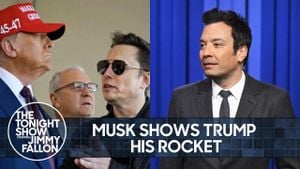International relations are often swayed by the smallest of diplomatic visits, and the upcoming trip of Russian President Vladimir Putin to India may set the stage for significant geopolitical shifts. This visit, anticipated soon, seeks to deepen the already complex ties binding India and Russia during a time of rampant global tension. Amid the persistent shadows of the Russo-Ukrainian War, both countries are examining their long-standing partnership through the lens of changing relationships with the West and mutual strategic interests.
One of the underpinning dynamics of these relations has been India's principled neutrality on the conflict. India hasn't once joined the chorus of nations condemning Russia's actions, opting instead to abstain from anti-Russian resolutions at the United Nations. This neutrality has allowed New Delhi to maintain beneficial trade links with Moscow, which have surged since the conflict commenced. Recently reported data shows bilateral trade between the two soaring from $12 billion in 2021 to approximately $65 billion last year. Such figures make India the second-largest buyer of discounted Russian oil after China, illustrating the economic interdependence forged between the nations.
While India has frequently called for respecting international law and encouraging peace to end the war swiftly, its economic dealings tell another story. The acquisition of cheaper oil has been instrumental to India's booming economy, which the International Monetary Fund predicts will climb to the world's third-largest economy by 2027. This dual approach allows India to criticize the war without jeopardizing its economic interests, effectively serving as both ally and critic, or as some may see it, as geopolitical pragmatists.
Compounding these dynamics, the backdrop of the incoming U.S. administration under Donald Trump adds another layer of complexity to Indo-Russian relations. Experts like Harsh V Pant from King’s India Institute warn of potential uncertainties once Trump assumes office. Trump's statements emphasizing the need to end the Ukraine war and his previously established affinities with Modi create ripe conditions for new dialogues aimed at peace. Should the trip occur before Trump's inauguration, it signifies Russia’s intent to solidify its position and the roadmap for its ties with India - all before the possibility of increased pressure from the U.S. lands on them.
While this burgeoning partnership suggests enduring ties, India must not overlook the larger backdrop, particularly China's increasing proximity to Russia, which has grown exponentially during the last two years. The war has not only affected West-Russian relations but has also altered the balance of global power, pushing Russia and China closer against the backdrop of mutual economic and political support. The necessity of India maintaining its relevance and influence amid such intertwined dynamics cannot be overstated.
Meanwhile, creating paths for enhanced trade remains on the agenda for both leaders. Targets have been set for raising bilateral trade to $30 billion by 2025, with current figures already indicating full-year trade has hit $65.70 billion. This upward trend covers not just oil but also pharmaceuticals and technology. Both nations are engaged deeply, exchanging investments across multiple sectors including railways, steel, and banking.
Interestingly, North Korea now finds itself embroiled alongside Russia within Ukraine’s conflict, prompting discussions on how such shifts will affect global dynamics and what this means for India's position. The Democratic People's Republic of Korea's military involvement is predicated on its partnership with Russia, underpinned by historical ties and strategic mutual benefit through the Comprehensive Strategic Partnership Agreement. Up to 12,000 North Korean troops may be deployed to combat zones, marking Pyongyang's intent to gather valuable combat experience against weakened adversaries.
This chapter is exemplified by Russia's operational adjustments, utilizing North Korean manpower to relieve pressure on its existing troops engaged on multiple fronts. This is yet another display of contemporary geopolitics reflecting historical partnerships and complex interactions again shifting global alignments. For countries like Ukraine and its Western allies, the involvement of North Korea reinforces concerns about Moscow's five-dimensional strategies and the unpredictable tactical advantages they justify.
At this juncture, Donald Trump's administration is predicted to push for reforms or resolutions toward the Ukraine crisis, determining how the new dynamics—whether strengthened ties between Moscow and Pyongyang or India's mediatory role—will play out. Indian Prime Minister Narendra Modi's previous visits to Russia and Ukraine hint at India's growing diplomatic interest and potential mediator status. Indeed, both leaders aim to lock down travel between their two nations, bolstering trust and investment opportunities.
While the need for India's involvement as mediator appears to grow, Trump’s strategists must tread carefully, gauging India’s influence without jeopardizing relations with traditional allies. Complexities abound, especially with public opinion and market reactions tied to how each player navigates their relationships. The effectiveness of any peace initiative likely hinges on each nation’s ability to understand and manage the potential fallout from Trump's international shifts.
Beyond trade and humanitarian corridors, the Indian legislation will need to adapt as its economic futures are interlinked with Russian energy exports, which now form the backbone of India’s energy consumption. Even as Modi approaches this delicate balancing act, Western sanctions' stipulations continue to float ominously overhead like clouds on the horizon, foretelling industry disruptions should the global order shift too far away from neutrality.
India's pragmatic partnership with Russia stands at this crux where opportunities like economic collaboration intersect with geopolitical challenges brought on by fluctuated global pressures. The push-and-pull between maintaining domestic satisfaction, advocating for global principles, and penetrating vast new markets becomes India's maze to navigate—potentially with President Putin’s visit sparking themes for renewed dialogue.
This ascent toward varying partnerships not only shades India's foreign policies but largest political entanglements within the Indo-Pacific region too. Trump’s directives will influence India’s strategy to counterbalance the influence of China should tensions peak again upon his return to the Oval Office. With Russia and North Korea crafting unusual counter-alliances and dynamics forming thereby on the Eurasian scale, India is forced to play its hand shrewdly, often contending with both long-time partners and newfound adversaries simultaneously.
The conclusion of this chapter could mark both strategic successes and failures, all dependent on forecasting where influence lies, be it with economic markets encapsulating Russia, North Korea, or shifting allegiances back to the West, as India seeks to find its position firmly and reliably. Modi and Putin's dialogue might just be the flicker before the impending shifts ignite entirely new paths for peace, or more pressingly, conflict. The political instruments each nation hauls out can set the framework for future engagements leading up to the very fate of not just the conflict, but the international order at large. The outcomes of these discussions could resonate far beyond their borders, potentially reshaping alliances and recalibrations of power for entire regions.



